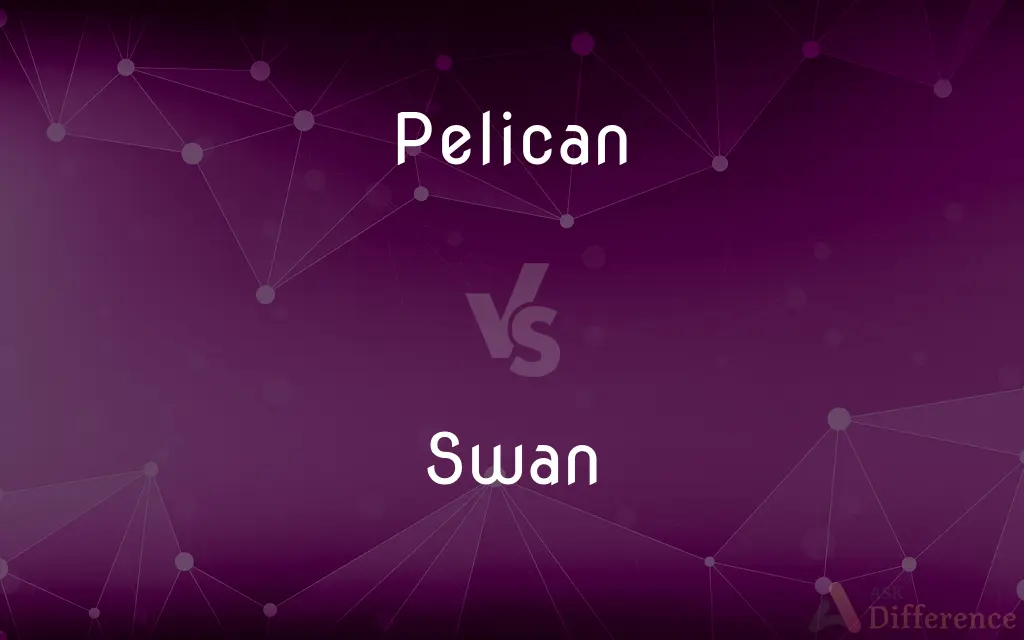Pelican vs. Swan — What's the Difference?
Edited by Tayyaba Rehman — By Urooj Arif — Updated on March 9, 2024
Pelicans are large waterbirds known for their distinctive pouches, while swans are recognized for their graceful appearance and long necks.

Difference Between Pelican and Swan
Table of Contents
ADVERTISEMENT
Key Differences
Pelicans are distinguished by their large bill and throat pouch used for catching fish, which is a key aspect of their feeding behavior. Whereas swans are noted for their elongated necks and are often associated with beauty and grace, playing a significant role in various cultural and literary contexts.
Pelicans are predominantly coastal birds that prefer salty or brackish waters, engaging in group fishing tactics. On the other hand, swans are more adaptable, inhabiting both freshwater and saltwater environments, often seen gliding majestically on lakes and ponds.
While pelicans have a more robust and heavy-set body, aiding in their plunge-diving fishing method, swans possess a sleek and streamlined form that allows for graceful swimming.
Pelicans are known for their social behavior, often found in flocks, and have a more gregarious nature. Swans, however, while they can be seen in groups, are more territorial and are often celebrated for their monogamous relationships that can last a lifetime.
Despite both being waterbirds, pelicans and swans have different flight characteristics. Pelicans are strong fliers with the ability to soar on thermals, whereas swans are powerful with their slow, rhythmic wingbeats and can travel long distances when migrating.
ADVERTISEMENT
Comparison Chart
Habitat
Coastal, prefers salty or brackish water
Freshwater and saltwater, lakes and ponds
Appearance
Large bill and throat pouch, robust body
Elongated neck, sleek and streamlined form
Behavior
Social, gregarious, group fishing
Territorial, monogamous, graceful swimming
Feeding
Plunge-diving for fish
Subsisting on aquatic vegetation and small animals
Flight
Strong, soars on thermals
Powerful, rhythmic wingbeats, migratory
Compare with Definitions
Pelican
Large waterbird with a distinctive throat pouch.
The pelican used its large bill to scoop fish from the water.
Swan
Elegantly long-necked waterbird, symbolizing grace.
The swan glided across the lake, its neck curved gracefully.
Pelican
Found in coastal and brackish water habitats.
We spotted a flock of pelicans near the lagoon.
Swan
Powerful flight capabilities, with slow, rhythmic wingbeats.
A flock of swans took off from the water, their wings beating slowly and powerfully.
Pelican
Social and gregarious in nature.
The noisy pelicans gathered in large flocks along the shore.
Swan
Inhabits both freshwater and saltwater environments.
Swans can be found in a variety of water bodies, from lakes to coastal bays.
Pelican
Engages in group fishing tactics.
A group of pelicans worked together to herd fish into shallow waters.
Swan
Often seen in pairs or small groups, known for monogamous pairs.
The pair of swans has returned to the same pond every year.
Pelican
Capable of impressive flight, including soaring on thermals.
We watched pelicans soaring high above the sea, riding the thermal currents.
Swan
Feeds on aquatic vegetation and small animals.
The swan dipped its head underwater to graze on aquatic plants.
Pelican
Pelicans are a genus of large water birds that make up the family Pelecanidae. They are characterized by a long beak and a large throat pouch used for catching prey and draining water from the scooped-up contents before swallowing.
Swan
Swans are birds of the family Anatidae within the genus Cygnus. The swans' closest relatives include the geese and ducks.
Pelican
Any of various large, web-footed birds of the genus Pelecanus primarily of tropical and warm regions, having a long straight bill from which hangs a distensible pouch of skin used for catching and holding fish.
Swan
A large waterbird with a long flexible neck, short legs, webbed feet, a broad bill, and typically all-white plumage.
Pelican
Any of various seabirds of the family Pelecanidae, having a long bill with a distendable pouch.
Swan
Move about or go somewhere in a casual, irresponsible, or ostentatious way
Swanning around Europe nowadays are we?
Pelican
A native or resident of the American state of Louisiana.
Swan
Any of various large waterbirds of the genera Cygnus and Coscoroba of the family Anatidae, having webbed feet, a long slender neck, and usually white plumage.
Pelican
A retort or still having a curved tube or tubes leading back from the head to the body for continuous condensation and redistillation.
Swan
Swan See Cygnus.
Pelican
(dentistry) A set of forceps used to force overcrowded teeth apart.
Swan
To travel around from place to place
"Swanning around Europe nowadays, are we?" (Jeffrey Archer).
Pelican
Any large webfooted bird of the genus Pelecanus, of which about a dozen species are known. They have an enormous bill, to the lower edge of which is attached a pouch in which captured fishes are temporarily stored.
Swan
To declare; swear. Used in the phrase I swan as an interjection. See Note at vum.
Pelican
A retort or still having a curved tube or tubes leading back from the head to the body for continuous condensation and redistillation.
Swan
Any of various species of large, long-necked waterfowl, of genus Cygnus (bird family: Anatidae), most of which have white plumage.
Pelican
Large long-winged warm-water seabird having a large bill with a distensible pouch for fish
Swan
(figuratively) One whose grace etc. suggests a swan.
Swan
(heraldry) This bird used as a heraldic charge, sometimes with a crown around its neck (e. g. the arms of Buckinghamshire).
Swan
(intransitive) To travel or move about in an aimless, idle, or pretentiously casual way.
Swan
To declare (chiefly in first-person present constructions).
Swan
Any one of numerous species of large aquatic birds belonging to Cygnus, Olor, and allied genera of the subfamily Cygninæ. They have a large and strong beak and a long neck, and are noted for their graceful movements when swimming. Most of the northern species are white. In literature the swan was fabled to sing a melodious song, especially at the time of its death.
Swan
Fig.: An appellation for a sweet singer, or a poet noted for grace and melody; as Shakespeare is called the swan of Avon.
Swan
The constellation Cygnus.
Swan
To declare or affirm solemnly and formally as true;
Before God I swear I am innocent
Swan
Move about aimlessly or without any destination, often in search of food or employment;
The gypsies roamed the woods
Roving vagabonds
The wandering Jew
The cattle roam across the prairie
The laborers drift from one town to the next
They rolled from town to town
Swan
Sweep majestically;
Airplanes were swanning over the mountains
Common Curiosities
Are swans or pelicans more social?
Pelicans are more social and gregarious, often seen in large flocks.
How do pelicans and swans adapt to their habitats?
Pelicans prefer coastal waters and use group tactics for fishing, whereas swans are adaptable to various water environments and feed on vegetation.
Can both pelicans and swans fly?
Yes, both are capable fliers, but they exhibit different flying patterns and capabilities.
Which bird is known for its monogamous relationships?
Swans are celebrated for forming lifelong monogamous pairs.
What is the primary habitat of a pelican?
Pelicans are primarily found in coastal and brackish waters.
What do swans typically eat?
Swans feed on aquatic vegetation and small aquatic animals.
What symbolizes a swan in many cultures?
Swans symbolize beauty, grace, and love in various cultural contexts.
Do swans migrate?
Yes, many swan species migrate seasonally over long distances.
What distinguishes a pelican's feeding behavior from a swan's?
Pelicans dive to catch fish, while swans graze on aquatic vegetation.
Why are swans often associated with romance?
Swans are associated with romance due to their beautiful, graceful appearance and lifelong pair bonds.
How do pelicans catch their food?
Pelicans use their large bill and pouch to scoop fish from the water.
Are pelicans or swans larger?
Both birds can be quite large, but pelicans generally have a bulkier appearance due to their large bill and pouch.
How do pelicans and swans differ in flight?
Pelicans are known for soaring on thermals, while swans have powerful, slow wingbeats.
Is the pelican bill unique among birds?
Yes, the pelican's bill is unique for its large size and the attached throat pouch.
How do pelicans socialize compared to swans?
Pelicans socialize in large flocks and engage in cooperative fishing, while swans are more territorial and form strong pair bonds.
Share Your Discovery

Previous Comparison
Loot vs. Plunder
Next Comparison
Tube vs. TubAuthor Spotlight
Written by
Urooj ArifUrooj is a skilled content writer at Ask Difference, known for her exceptional ability to simplify complex topics into engaging and informative content. With a passion for research and a flair for clear, concise writing, she consistently delivers articles that resonate with our diverse audience.
Edited by
Tayyaba RehmanTayyaba Rehman is a distinguished writer, currently serving as a primary contributor to askdifference.com. As a researcher in semantics and etymology, Tayyaba's passion for the complexity of languages and their distinctions has found a perfect home on the platform. Tayyaba delves into the intricacies of language, distinguishing between commonly confused words and phrases, thereby providing clarity for readers worldwide.
















































